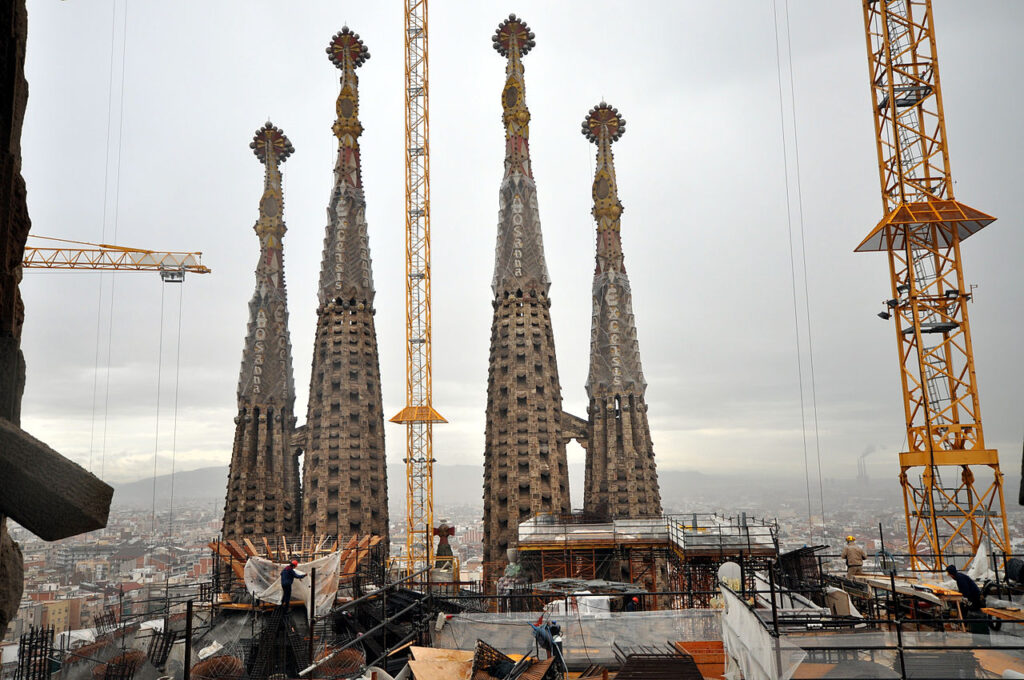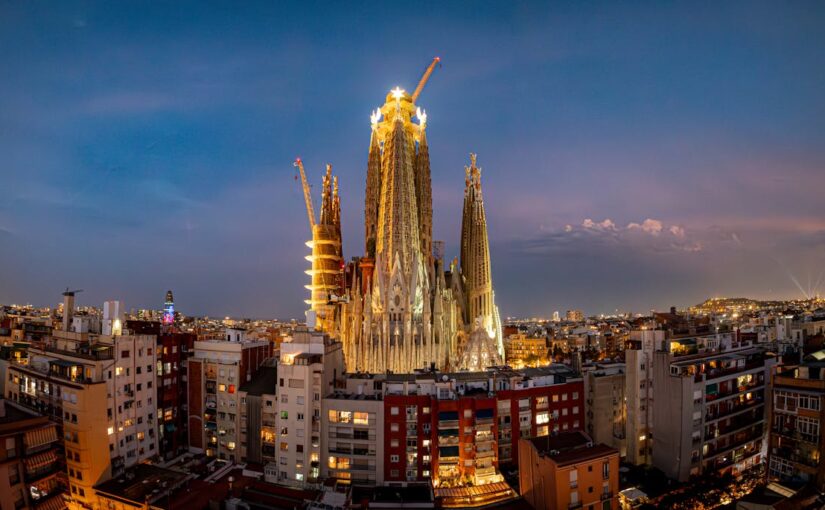Barcelona has many treasures, but none captures the spirit of the city more than Antoni Gaudí’s unfinished masterpiece, the Basílica de la Sagrada Família. Rising above its surroundings with an otherworldly presence, it is the most visited monument in Spain, drawing nearly five million visitors in 2024 alone. People from every corner of the world flock to its doors, craning their necks beneath its towers, marveling at its stained glass, and whispering their awe into the vast space where devotion meets spectacle. Now, the basilica stands at the threshold of a historic moment. With the construction of its fourteenth tower, known as the Jesus Christ Tower, the Sagrada Família is poised to claim a new title: the tallest church tower in the world.
Gaudí’s Vision and Legacy
The story of this extraordinary basilica begins with Antoni Gaudí, the Catalan architect who combined artistry, spirituality, and engineering genius in ways no one else dared. Born in 1852, Gaudí grew up in poverty but showed an early fascination with nature, geometry, and religion. His architectural philosophy was rooted in the idea that human creations should reflect the harmony of God’s creation. For him, a building was not a shell of stone but a living body infused with divine purpose.
Gaudí devoted the last twelve years of his life solely to the Sagrada Família and spent much of that time living in a small workshop beside the site. When he died in 1926 after being struck by a tram, the basilica was barely a fraction complete. Yet he had left behind detailed plans, models, and designs. Over generations, his students and later architects have continued the work, adapting his ideas to modern techniques while remaining faithful to his vision.
Gaudí’s humility before God became central to his designs. He insisted that the basilica never surpass the height of Montjuïc, Barcelona’s iconic hill, which stands at 173 meters. Accordingly, the central Jesus Christ Tower now under construction is planned at 172.5 meters. This symbolic gesture reflects Gaudí’s belief that no human work should overshadow God’s natural creation, even while aspiring upward in glory.
The Jesus Christ Tower
The Jesus Christ Tower marks the culmination of Gaudí’s grand design. At 172.5 meters, it will surpass the long-standing record held by Ulm Minster in Germany, whose spire rises to 161.5 meters. For 135 years Ulm has been the tallest church tower in the world, but soon Barcelona will claim that honor.
Unlike the standard spires of Gothic cathedrals, the Jesus Christ Tower is accompanied by thirteen others, each dedicated to a figure in Christian theology, together forming a blend of geometry and symbolism. To crown the tower, an immense cross is being crafted in Bavaria. Measuring 17 meters in height and weighing 100 tons, it will have four arms stretching 13 meters across. The cross itself is designed to be visited, with small windows allowing visitors to gaze across the entire city and out to the Mediterranean. By day, it will stand as a monumental landmark, and by night it will glow from within, a luminous beacon over Barcelona.
If construction stays on schedule, the consecration of the tower will take place on June 10, 2026, exactly one hundred years after Gaudí’s death. A papal presence, possibly from Pope Leo XIV, is anticipated to mark this extraordinary milestone.

Inside the Sagrada Família
While the new tower commands headlines, the interior of the basilica continues to captivate those who step inside. Light plays a central role in Gaudí’s design. The stained glass windows throw the colors of dawn in blues and greens at one end of the church and the fiery reds and oranges of sunset at the other, creating a symphony of light that changes throughout the day. Visitors often describe the experience as walking inside a forest of stone, with towering pillars branching upward like trees.
A traveler from the United States recently exclaimed, “Oh wow, this is amazing!” A mother from Munich, visiting with her three children, admitted the basilica was more beautiful inside than she had imagined, different from any church she had ever seen. Moments like these illustrate what sets the Sagrada Família apart. For some, it is a space of prayer and devotion, with regular Mass taking place in the crypt. For others, it is the highlight of a European journey, a magnificent stop on a cultural pilgrimage. Both groups stand side by side beneath its vaults, necks tilted back, phones raised high, caught in the same spell of wonder.
Historical and Cultural Significance
The Sagrada Família is not just Barcelona’s centerpiece, it is also a symbol of Spanish identity and resilience. In 2010, Pope Benedict XVI consecrated the church as a basilica, an honorific title that elevated its status in the Catholic world. His words described it as a “wonderful synthesis of faith, art, and technology.” Even so, words often fail to capture the emotional power of the building. Gaudí himself considered it less a creation of stone than a spiritual offering in architectural form.
Through decades of political turmoil, including civil war and dictatorship, the basilica endured. Critics once dismissed it as eccentric or even grotesque. George Orwell himself called it one of the ugliest buildings he had ever seen and suggested tearing it down. Time, however, has reversed those judgments. Today, it is universally recognized as a masterpiece of world heritage, an icon of architecture as much as the Eiffel Tower in Paris or St. Peter’s in Rome.
How the Sagrada Família is Built
Perhaps one of the most remarkable aspects of the Sagrada Família is how it is funded. Unlike medieval cathedrals financed by monarchs or modern structures financed by the church and state, the Sagrada Família has always depended on the contributions of visitors. The 1992 Barcelona Olympics thrust the city onto the global stage, sparking a surge of tourism that continues to fund its construction.
The COVID-19 pandemic in 2020 briefly halted work when closures cut off visitor income, but momentum has since returned. Today, people from around the world are core contributors to the basilica’s completion. Visitors from the United States make up the largest group, nearly one in five tourists. Others come from France, Italy, Korea, and Spain itself. Germans, curiously, are less numerous, preferring to flock to the nearby beaches. Every entrance ticket purchased, however, brings Gaudí’s vision closer to fulfillment.
Looking Ahead: The Final Stages
The upcoming consecration of the Jesus Christ Tower will mark another chapter, not the conclusion. Still to be completed is the southern Gloria façade, envisioned as the grandest of them all. It will portray the themes of heaven and hell, and when completed it will add four more towers, bringing the total to eighteen. This construction alone is expected to take ten to twelve years, provided unforeseen disruptions like another pandemic do not intervene.
A controversial debate surrounds the plan for a large esplanade in front of the Gloria façade. To create space, several residential buildings along Calle Mallorca would need to be demolished. While planners argue such an open area would give the basilica the grandeur of perspective it deserves, residents understandably resist the idea of sacrificing their homes for it. The city awaits a decision, torn between preserving neighborhood life and honoring Gaudí’s master plan.
Balancing Faith and Tourism
The Sagrada Família today sits at the crossroads of two identities. It is both a consecrated place of worship and one of the busiest tourist sites in the world. Some critics lament that the devotional purpose of the building is drowned out by the sound of tour groups and clicking cameras. Yet this coexistence is perhaps fitting. Gaudí envisioned a church for all humanity, a space where faith, beauty, and community could converge.
The question of whether today’s construction is truly authentic to Gaudí’s spirit continues to spark debate. Architect Jordi Faulí, the current chief overseeing the project, describes himself humbly not as Gaudí’s successor but as his collaborator. For many visitors, such debates matter less than the awe they feel when they step inside this extraordinary structure. The building transcends the particulars of its architects and belongs instead to the world.
Toward Completion
As the Jesus Christ Tower reaches for the sky and prepares for consecration in 2026, the Sagrada Família stands on the verge of becoming not just the tallest church tower, but also the ultimate embodiment of Gaudí’s dream. What began as a wild vision more than a century ago has grown into one of humanity’s most ambitious architectural projects.
The Sagrada Família represents more than stone and glass. It embodies devotion, persistence, and the collective contribution of millions. For Barcelona, it is both a landmark and a heartbeat, shaping its skyline and its global identity. For travelers, it is a destination that offers more than sightseeing, it offers wonder, reflection, and inspiration.
When its eighteen towers are finally complete, the Sagrada Família will stand as one of humanity’s great achievements, as timeless as the pyramids or the Parthenon. Until then, every crane at its summit, every ticket purchased, and every visitor’s whispered “amazing” carries this dream forward. The basilica is not just growing taller, it is reaching deeper into the shared cultural soul of our modern world.
Photo by Christopher Politano.
If our work has inspired you, helped you grow, or simply brought a little warmth to your day, consider supporting Thalysia.com with a small donation. Your contribution helps us continue exploring ancient landscapes, documenting local traditions, and celebrating the art of living well.
